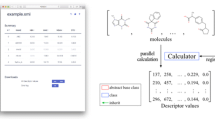Abstract
We discuss properties of the autocorrelation descriptor, a topological descriptor encoding both molecular structure and physico-chemical properties of a molecule. We introduce two random graph models for molecules and show that this descriptor may exhibit unwanted correlation properties, making the generated data unusable for structure–activity relationship studies. This shortcoming can easily be eliminated by centering properties, facilitating subsequent statistical analysis.
Similar content being viewed by others
References
H. Kubinyi, QSAR: Hansch Analysis and Related Approaches (VCH, 1993).
L.B. Kier and L.H. Hall, Molecular Connectivity in Structure Activity Analysis (Wiley, 1986).
N. Trinajstić, Chemical Graph Theory (CRC Press, 1992).
D. Bonchev and D.H. Rouvray (eds.), Chemical Graph Theory, Vols. 1 and 2 (Gordon & Breach, 1991, 1992).
H. Wiener, Structural determination of parrafin boiling points, J. Am. Chem. Soc. 69 (1947) 17–20.
G. Moreau and P. Broto, Autocorrelation of a topological structure: A new molecular descriptor, Nouv. J. Chim. 4 (1980) 359–360.
J. Devillers and D. Domine, Comparison of reliability of log P values calculated from a group contribution approach and from the autocorrelation method, SAR QSAR Environ. Res. 7 (1997) 195–232.
M. Wagener, J. Sadowski and J. Gasteiger, Autocorrelation of molecular properties for modelling corticosteroid binding globulin and cytosolic Ah receptor activity by neural networks, J. Am. Chem. Soc. 117 (1995) 7769–7775.
J. Devillers, Autocorrelation descriptors for modelling (eco)toxicological endpoints, in: Topological Indices and Related Descriptors in QSAR and QSPR, ed. J. Devillers (Gordon & Breach, 1999) pp. 595–612.
H. Bauknecht, A. Zell, H. Bayer, P. Levi, M. Wagener, J. Sadowsky and J. Gasteiger, Locating biologically active compounds in medium-sized heterogeneous datasets by topological autocorrelation vectors: Dopamine and benzodiazepine agonists, J. Chem. Inf. Comput. Sci. 36 (1996) 1205–1213.
J. Devillers, D. Domine and R.S. Boethling, Use of a backpropagation neural network and autocorrelation descriptors for predicting the biodegradability of organic chemicals, in: Neural Networks in QSAR and Drug Design, ed. J. Devillers (Academic Press, 1996) pp. 65–82.
http://www.disat.unimib.it/chm/Dragon.htm
B. Bollobas, Random Graphs (Academic Press, 1984).
E.M. Palmer, Graphical Evolution (Wiley, 1985).
B. Hollas, Correlation properties of the autocorrelation descriptor for molecules, Comm. Math. Chem. (MATCH) 45 (2002) 27–33.
J. Köbler, U. Schöning and J. Toran, The Graph Isomorphism Problem: Its Structural Complexity (Birkhäuser Verlag, Boston, 1993).
Author information
Authors and Affiliations
Rights and permissions
About this article
Cite this article
Hollas, B. An Analysis of the Autocorrelation Descriptor for Molecules. Journal of Mathematical Chemistry 33, 91–101 (2003). https://doi.org/10.1023/A:1023247831238
Issue Date:
DOI: https://doi.org/10.1023/A:1023247831238




